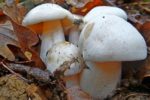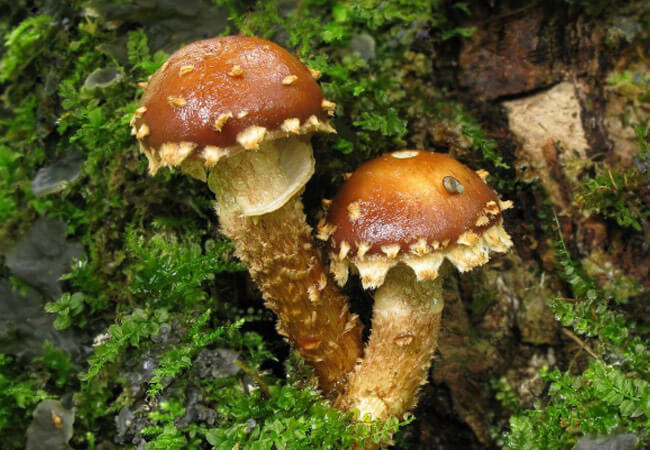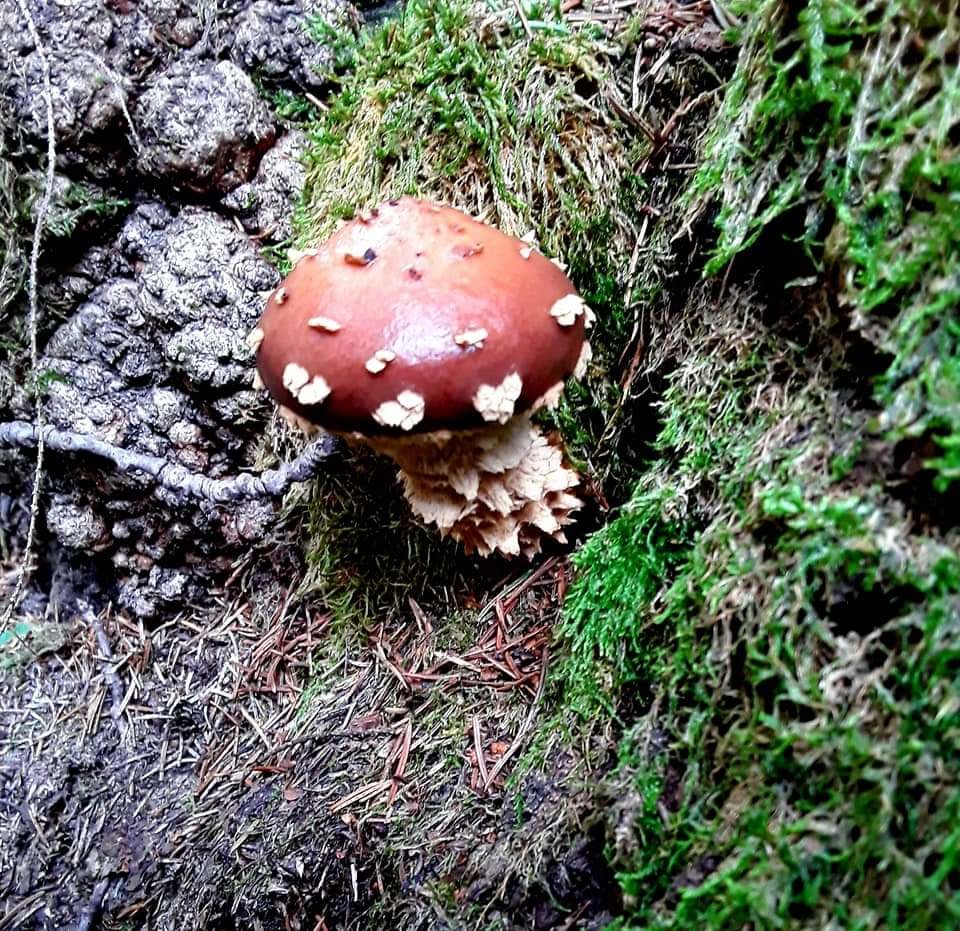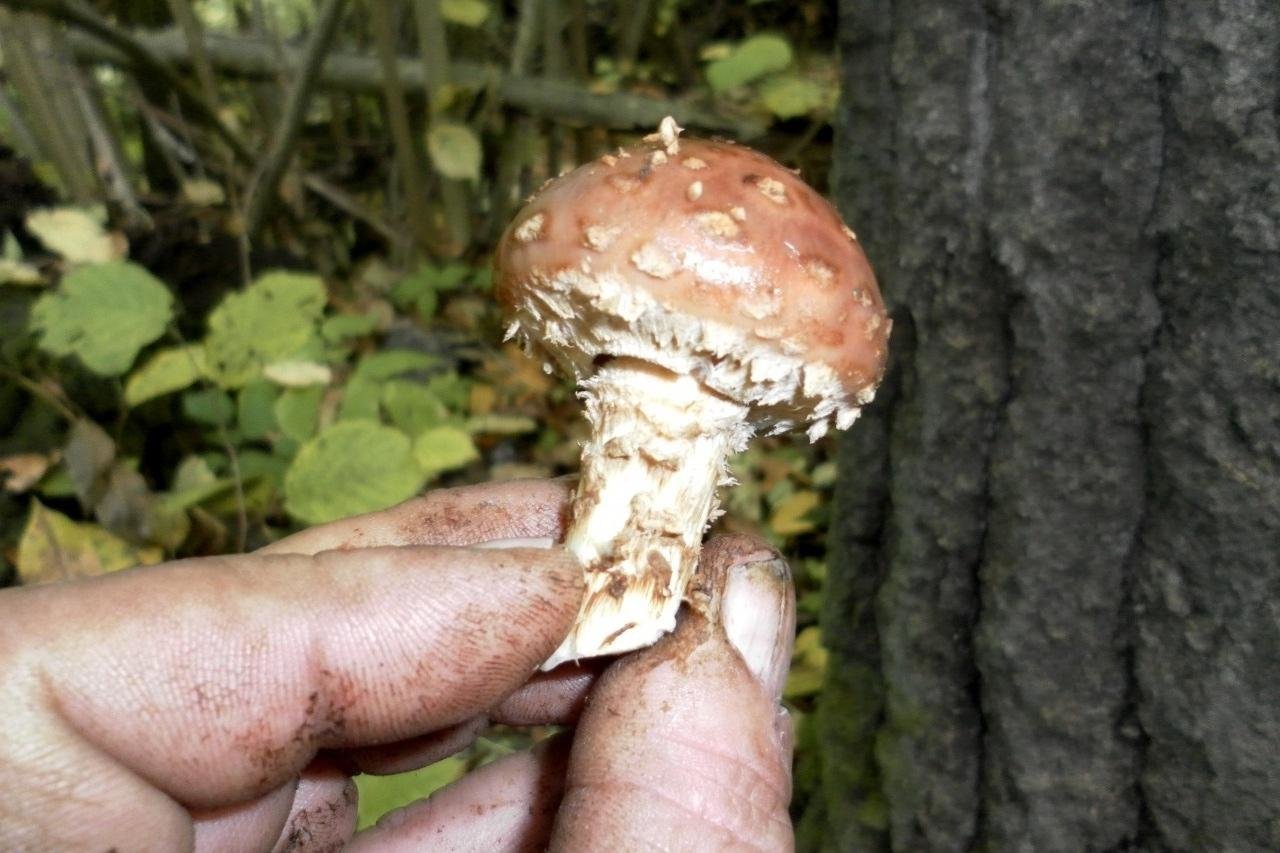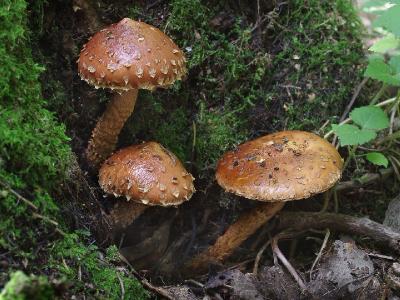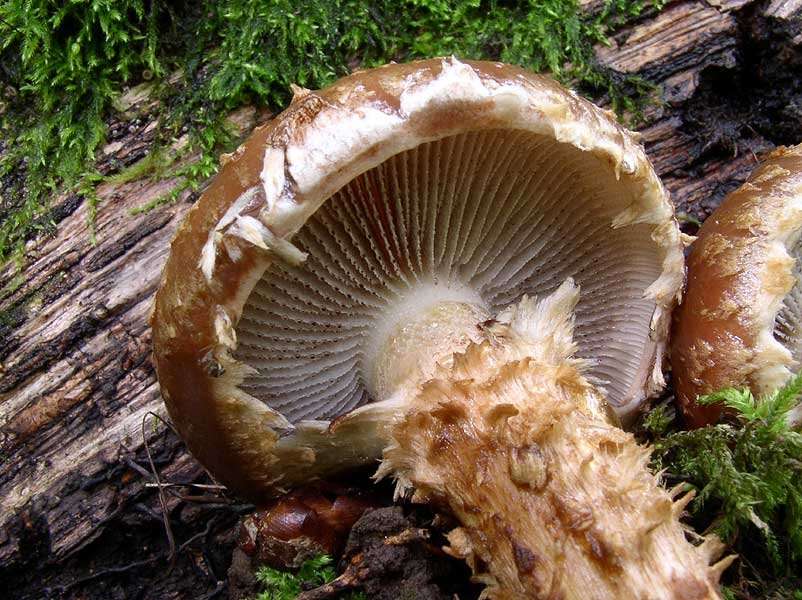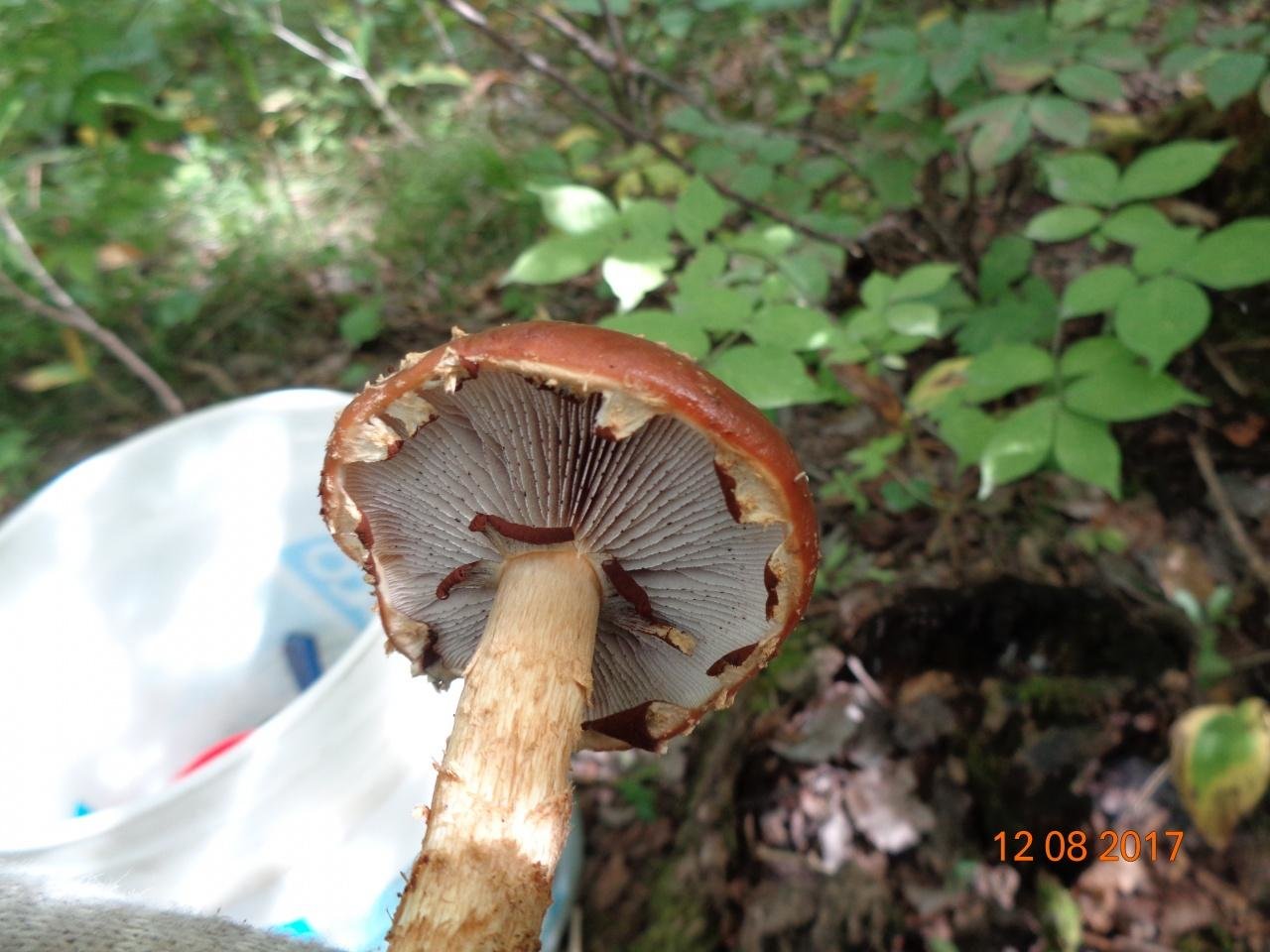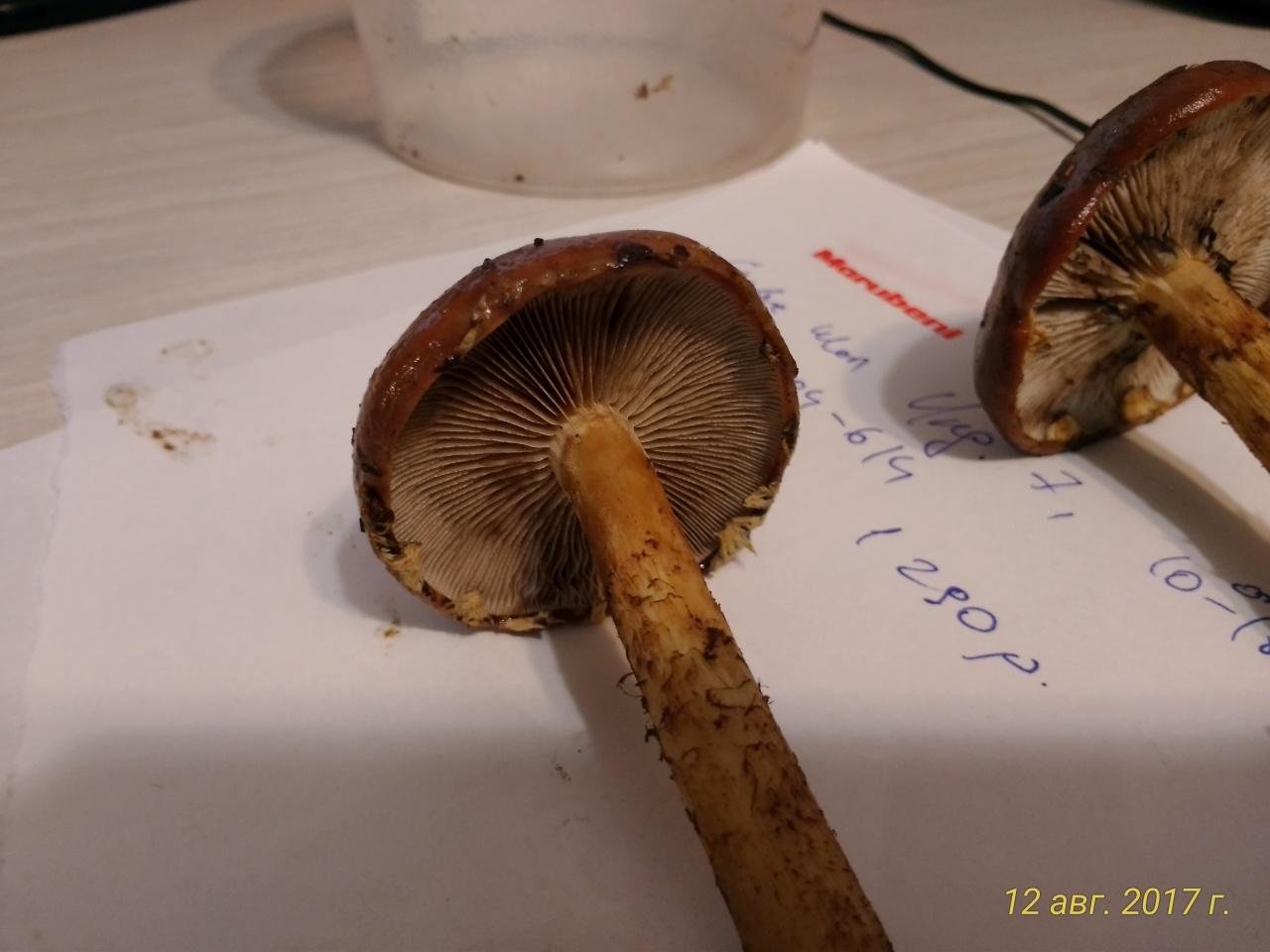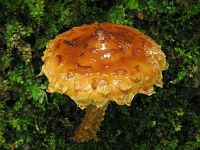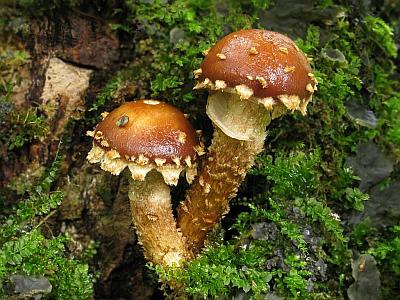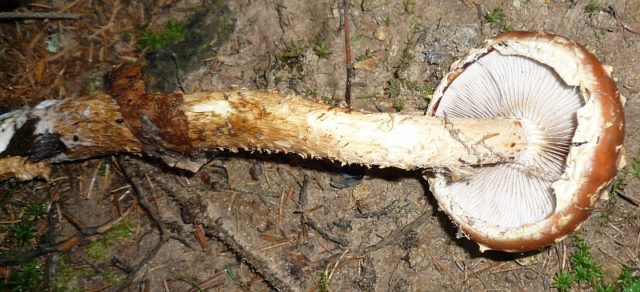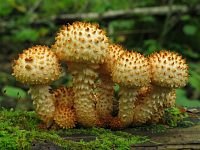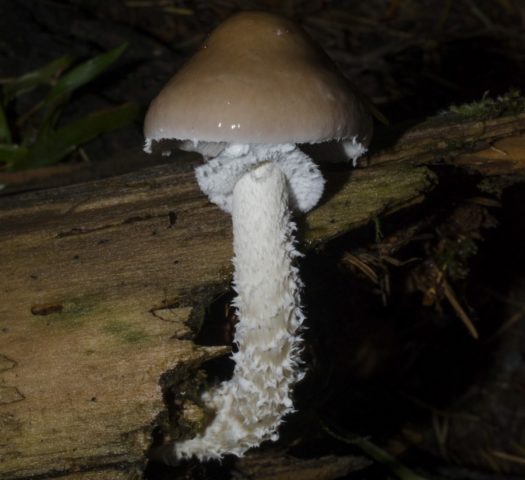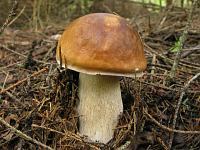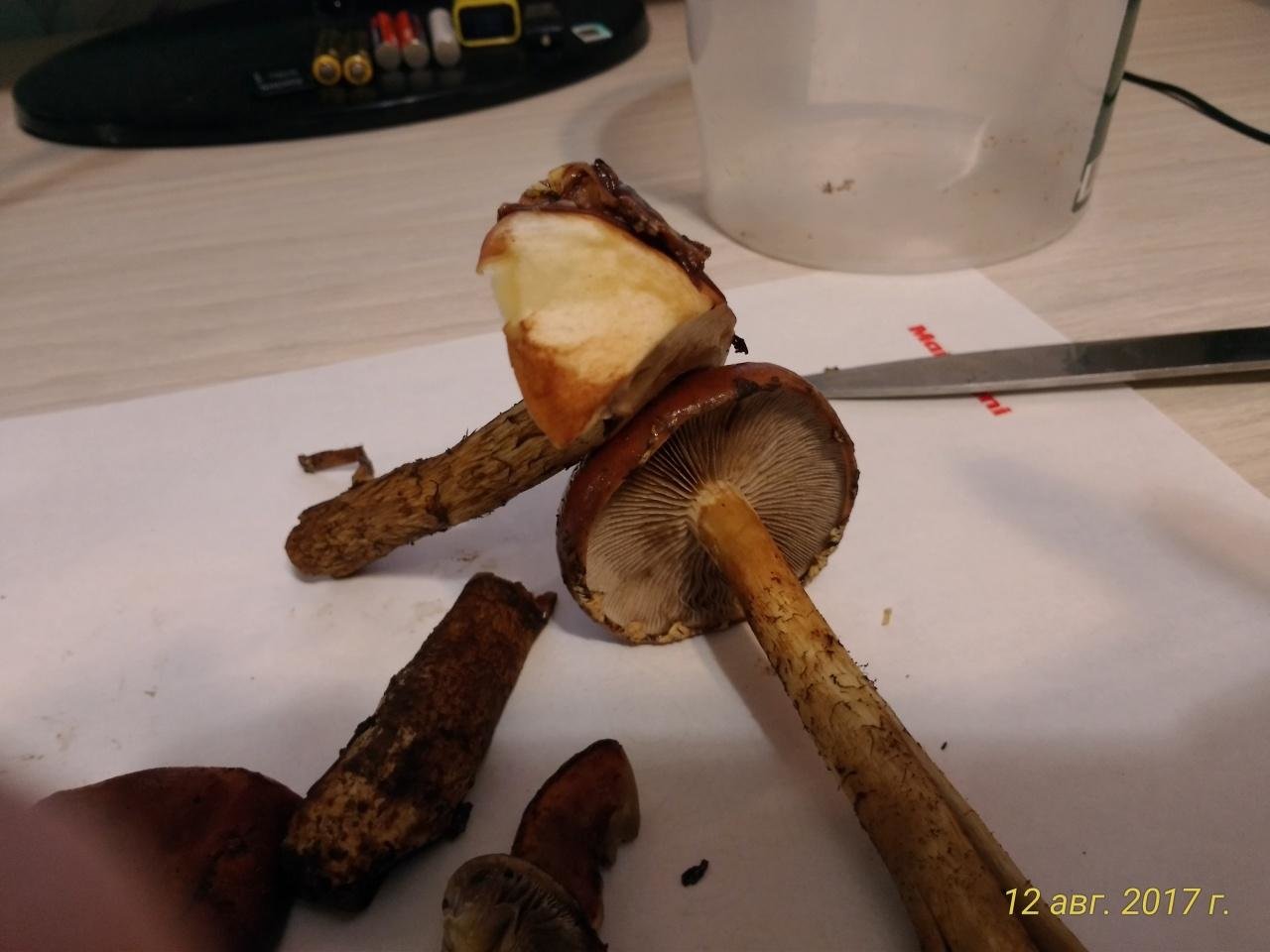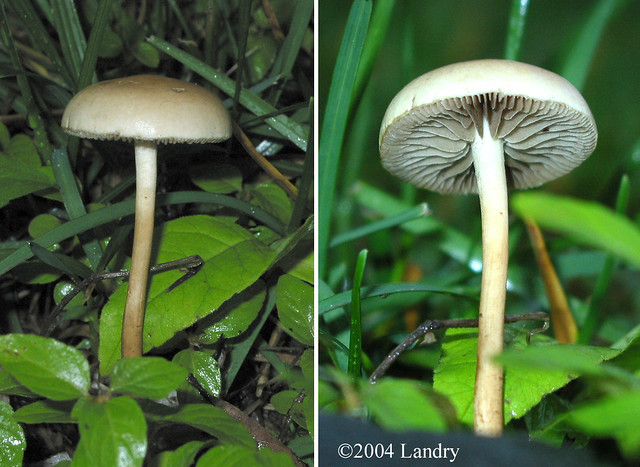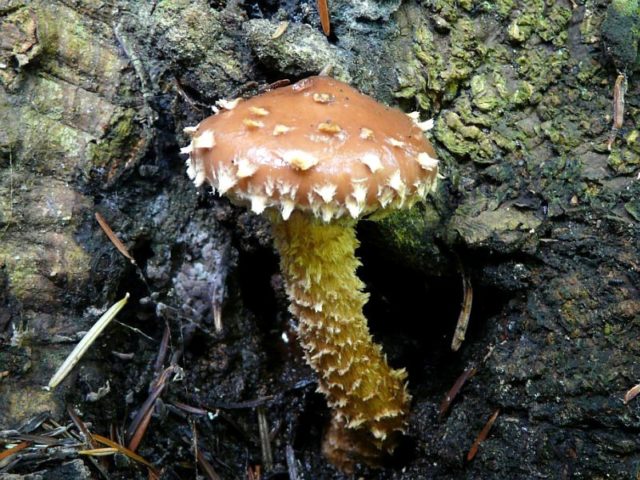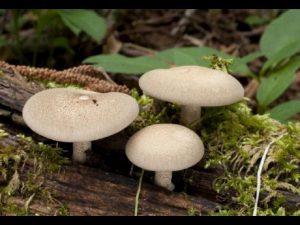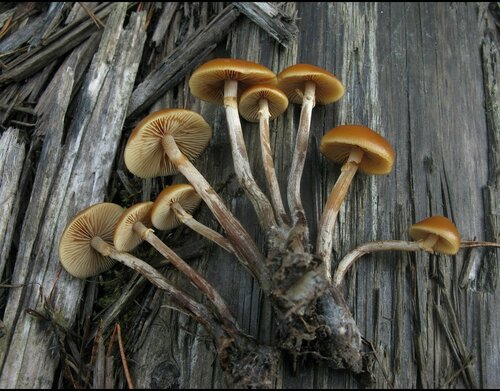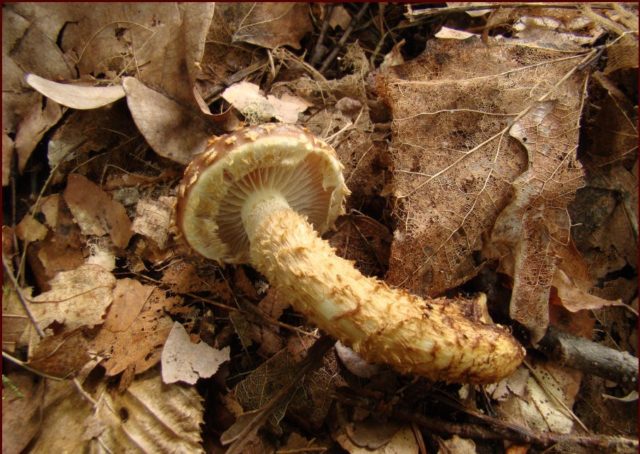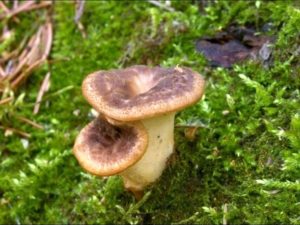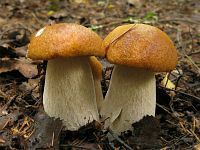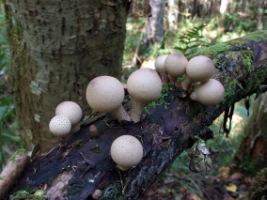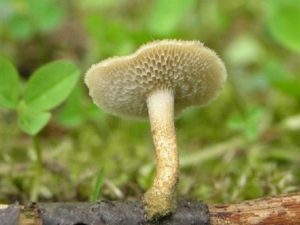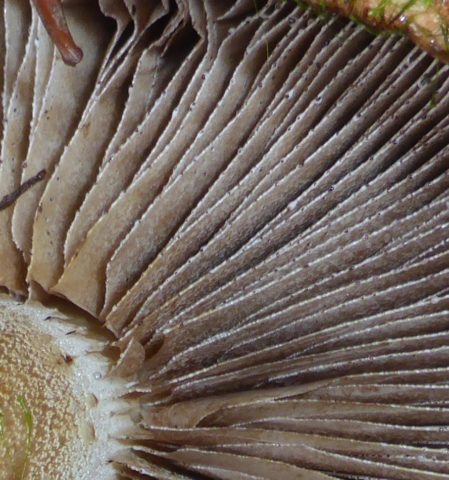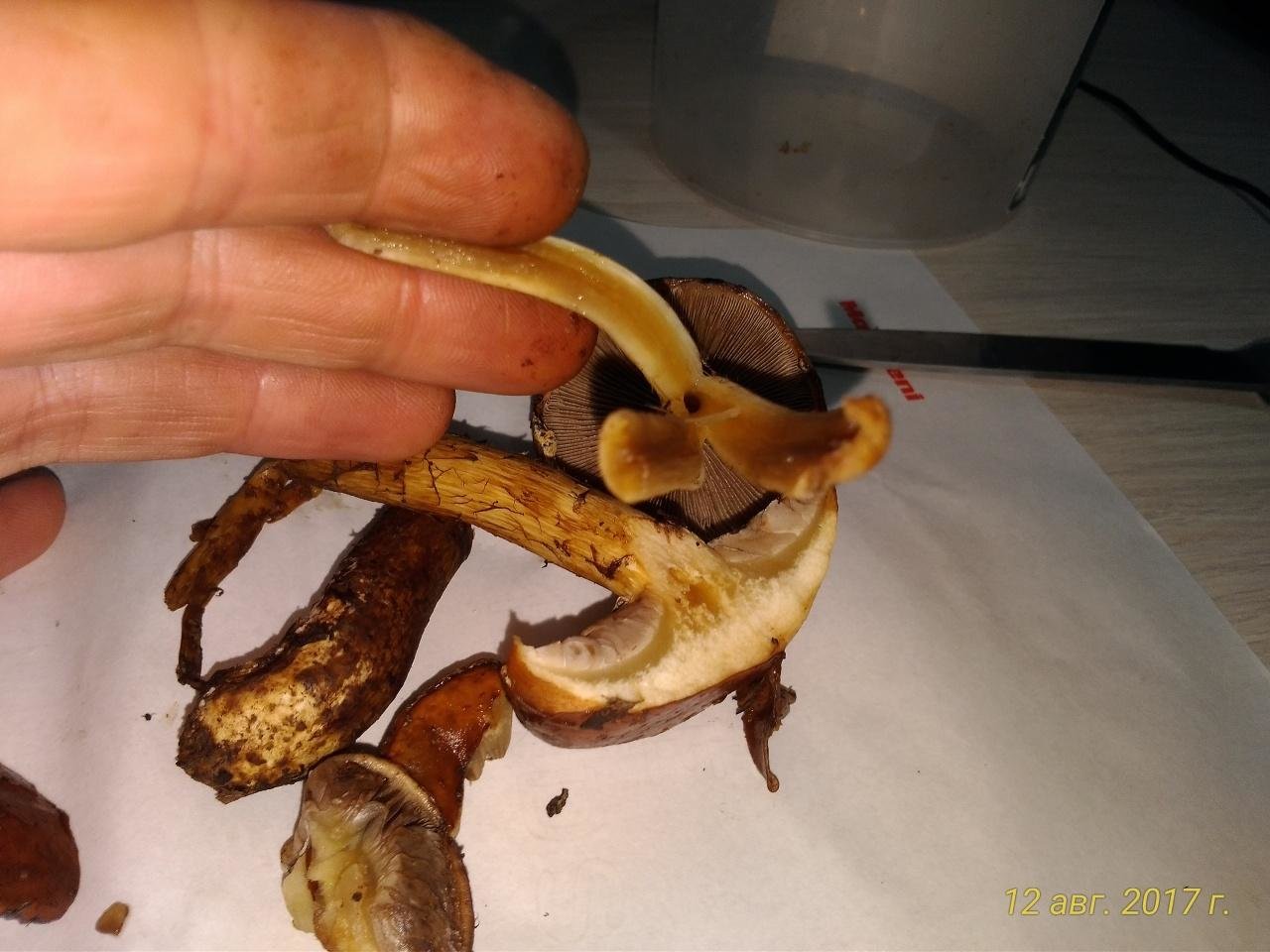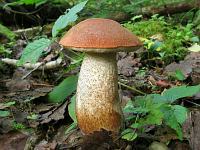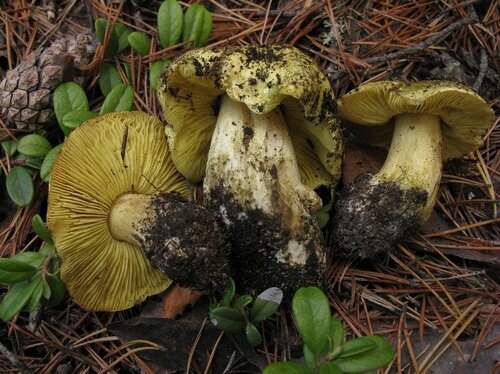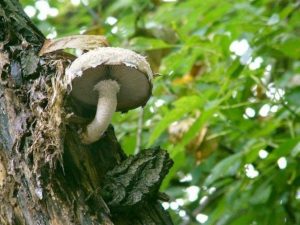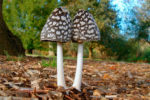External signs
Mushroom cap
Baby scales boast a pretty bell-shaped cap, which, with the growth of the fungus, becomes wider, flat-convex with a characteristic tubercle in the center. On average, the width of the cap varies between 5-8 cm.However, under favorable conditions, it can grow up to 12 cm.
The color of the cap cannot be called unambiguous, because, depending on the climate and age, the shade can change from reddish brown and chestnut to brown and dark brown.
The entire outer area of the cap is covered with light yellow fibrous scales spreading concentrically. However, there are more mature individuals without such scales.
Along the edge of the cap, as if with a fringe, it is decorated with hanging plates. The skin of the fungus is slimy, especially during periods of moisture, and easily falls off. In dry weather, the mushroom can be completely dry.
The white-crested scaly has a lamellar hymenophore. The plates themselves in young specimens are light with a slight purple tint. It is this color that is the distinguishing feature of this type of mushroom.
Often among the "youth" along the edge of the plates one can see light droplets with an oily structure. And during the growth of the fungus, brown-violet clusters are formed inside these droplets.
As the hymenophore of the scale grows older, it darkens, acquiring a brown-green, brown-violet dark shade. In addition, the edges of the plates become jagged.
Stipe
The dense legs of young scales become hollow in old age. Their length does not exceed 9 cm, and the average thickness is 1 cm.
There are pronounced rings on the legs, turned upwards, like sockets. If above the ring the leg has a smooth surface, then below the ring the body of the leg looks shaggy due to the dense coverage with fibrous scales of light color. With age, the scales grow profusely, and the ring becomes almost invisible.
It is because of the light color that the scales are so noticeable and voluminous against the background of a brown, dirty orange or yellowish leg.
White-crested scaly - lat. Hemistropharia albocrenulata
Stropharia crown (Psilocybe coronilla)
Synonyms:
- Stropharia obturata
- Agaricus coronillus

Hat:
in a young mushroom, the cap has a conical shape, then straightens and becomes prostrate. The surface of the cap is smooth. Sometimes it is covered with small scales. The hat is hollow inside. The edges of the cap are bordered by flaky scraps of the bedspread. The diameter of the cap is from 2 to 8 centimeters. The surface of the cap can take on all shades of yellow, starting from light yellow and ending with lemon. Sometimes the cap is colored unevenly. Lighter on the edges. In wet weather, the skin of the cap becomes oily.
Leg:
cylindrical stem, slightly tapering towards the base. At first, the leg is solid inside, then it becomes hollow. The leg is distinguished by its characteristic root shoots extending into the soil. On the stem there is a small, early disappearing ring of purple color from ripe, crumbling spores.
Plates:
not frequent, unevenly adhered to the peduncle with a tooth or tightly. In young mushrooms, the plates are pale lilac in color, then they become dark, purple or brown.
Variability:
The mushroom is different variability in cap color (from light yellow to bright lemon) and variability in the color of the plates (from light lilac in young mushrooms to blackish brown in mature mushrooms).
Spreading:
Stropharia crown occurs in meadows and pastures. Prefers manured and sandy soils. It can grow both on plains and on low hills. Grows in small groups, rather scattered. Never forms large clusters. More often it grows singly or two or three mushrooms in an aggregate. Fruiting period from summer to late autumn.
Spore Powder:
violet brown or dark purple.
Pulp:
the flesh in the stem and in the cap is dense, whitish in color. The mushroom has a rare smell. Some sources claim that the mushroom smells good.
Edibility:
there is conflicting information about the edibility of crown stropharia. Some sources indicate that the mushroom is conditionally edible, others, like the inedible mushroom. There is also information that the mushroom is possibly poisonous. Therefore, most likely, it is not worth eating it.
Similarity:
bears similarities to other inedible small stropharias.
Notes: Stropharia crown, although small, is a very strong and dense mushroom. Very often, the hemispherical shape of the cap hides a relatively short stem, which gives the impression that beautiful yellow round lilies are scattered in the grass. Mushrooms are surprisingly combined with green grass, so you shouldn't pick them, even just for aesthetic reasons. Some species may differ in color, spore size. They are even divided into two separate subspecies: Stropharia melasperma and Stropharia halophila.
Scaly mucosa: photo and description
| Name: | Scaly mucosa |
| Latin name: | Pholiota lubrica |
| Type of: | Conditionally edible |
| Specifications: |
|
| Systematics: |
|
The fungus of the stropharia family of flakes is distributed throughout the country. There are many varieties of it: slimy scaly, fiery, golden and other types.
Mushrooms are considered conditionally edible, have beneficial properties used for treatment in traditional medicine. They grow in small families on stumps, roots and in the hollows of trees (most often birches and willows).
What does scaly mucosa look like?
Externally, the scaly mucosa is similar to honey agarics, it grows in the same groups. The avid mushroom pickers of our country most often neglect this species, mistaking it for a toadstool.
In eastern countries, flake is very popular, occupies a worthy place in cooking, and is grown in artificially created conditions.
This mushroom is also called mucous champignon, flamulla, fiberglass and greenlandic scaly.
Description of the hat
In young specimens of flamulla, the mucous cap is bell-shaped with a closed edge. With growth, the cap becomes slightly concave and unfolded, reaching 50 - 100 mm in size.
The color of the cap is brown, more saturated in the center. It is covered with a matte skin, abundantly covered with scales. In damp weather, the skin becomes sticky. At the edges of the cap, you can find the remains of the blanket, washed away by the rain during the growth.
As it grows, the hat bottom is covered with weak yellow-green plates, occasionally covered with brown spots.
Leg description
The cylindrical hollow leg of a young mushroom is usually crooked, has a height of up to 10 cm, and its diameter is no more than 10 mm. As it grows, the cavity of the leg is filled with cotton pulp.
There is a yellowish ring on the leg of a young scale, which quickly disappears. The edges of the ring are red in color, and under the ring itself there are many scales.
Is the mushroom edible or not
The mucous fiber is a conditionally edible mushroom. All parts of young specimens and caps of adult mushrooms are suitable for food. During processing, the legs become very hard and tasteless, and therefore are not used in cooking.
Despite the fact that mucous flakes lack a strong mushroom aroma, they are suitable for cooking main courses and pickling. Gourmets refer to the type of flakes as a delicacy. Before the main stages of cooking, the mushrooms must be boiled for a quarter of an hour. Drain the water. This is how they get rid of the inherent bitterness.
The healing properties of mucous scales
Currently, the types of fungi of scale are not fully understood.Scientific studies carried out in laboratory conditions on white mice have shown that in the fibrous mucosa there are substances that can stop the growth of tumor cells.
Where and how it grows
The localization and method of growth of this type of mushroom is similar to the mushrooms, which are widely known to avid mushroom pickers. Scaly scales grow on rotten, rotten wood. It settles in small families, prefers coniferous and mixed forests with a temperate climate.
In Russia, it is widespread in Karelia, in the Far East, in the forests of the Urals and Siberia. Fruiting begins in late August and lasts until the first frost.
Doubles and their differences
Due to the fact that flake is little known among mushroom pickers, it is often confused with other types:
- Honey mushrooms. In contrast to the fiberglass, honey agarics have a denser ring of the leg and the plate of the cap. The color is also excellent. Honey mushrooms are considered conditionally edible and are widely used in cooking;
- Blue-bore spiderwebs (staining) are an inedible type of mushroom that grows on mosses in swampy areas. Cobwebs have a different color from flamull: ocher with a bluish tint or violet-blue color.
Conclusion
Despite the fact that slimy scales are little known, and few fans of mushroom hunting pay due attention to it, the mushroom has some advantages. With proper culinary processing, delicious dishes and blanks are obtained from it.
The medicinal properties suggest that eating and as a medicinal raw material can benefit the body.
White-crested scaly (Hemistropharia albocrenulata)
Synonyms:
- Pholiota albocrenulata
- Hebeloma albocrenulatum
- Stropharia albocrenulata
- Pholiota fusca
- Agaricus albocrenulatus
- Hemipholiota albocrenulata
Hemistropharia is a genus of lamellar fungi, the classification of which is still somewhat ambiguous. Perhaps the genus is related to Hymenogastraceae or Tubarieae. Monotypic genus, contains one species: Hemistropharia albocrenulata, Russian name White-crested scaly.
This species, originally named Agaricus albocrenulatus by the American mycologist Charles Horton Peck in 1873, has been renamed several times. Other names include Pholiota albocrenulata and Stropharia albocrenulata. The genus Hemistropharia strongly resembles the typical Pholiota (Foliota), it is in this genus that the white-crowned scaly was originally classified and described, and it is considered a wood-destroying fungus, like the real Foliota.
Microscopic differences: Unlike Pholiota, Hemistropharia has no cystidia and darker basidiospores.
Description
Hat: 5-8, under good conditions, up to 10-12 centimeters in diameter. In young mushrooms, it is bell-shaped, hemispherical, with growth it acquires a flat-convex shape, may be broadly bell-shaped, with a pronounced tubercle.
The surface of the cap is covered with concentrically located wide, light (slightly yellowish) lagging fibrous scales. In adult specimens, scales may be absent.
On the lower edge of the cap, white felt hanging scales are clearly visible, forming an elegant fringe.
The color of the cap varies, the color range is red-brown to dark brown, chestnut, chestnut-brown.
The skin of the cap is slimy in wet weather and can be easily removed.
Plates: adherent, frequent, very light in young mushrooms, light gray-violet. Most sources indicate this detail - plates with a faint purple tint - as a distinctive feature of white-bellied scales. Also, young mushrooms often have white, light, oily drops on the edges of the plates. In older mushrooms, it is noted that dark purple-brown clusters can be seen inside these droplets.
With age, the plates acquire chestnut, brown, greenish-brown, violet-brown colors, the edges of the plates may be jagged.
Leg: 5-9 centimeters high and about 1 cm thick. Dense, solid, hollow with age. With a fairly well-defined white ring in young mushrooms, turned upwards, like a bell; with age, the ring acquires a somewhat "ragged" appearance, it may disappear.
Above the ring, the stem is light, smooth, longitudinally fibrous, longitudinally striped.
Below the ring, it is densely covered with large, light, fibrous, strongly protruding scales. The color of the leg between the scales is yellowish, rusty, brown to dark brown.
Flesh: light, whitish, yellowish, more yellow with age.Dense. Odor: no special smell, some sources note a sweetish or weak mushroom. Obviously, a lot depends on the age of the mushroom and the growing conditions. Taste: bitter.
Spore powder: brown-violet. Spores 10-14 x 5.5-7 microns, almond-shaped, with a pointed end. Cheilocystids are bottle-shaped.
Season and distribution
It parasitizes living hardwood, most often aspen. It can grow in tree holes and roots. It also grows on rotten wood, also mainly aspen. It is found infrequently, in small groups, in the summer-autumn period.
In Russia, it is recorded in the European part, in Eastern Siberia and in the Far East. Outside Russia, it is distributed in Europe, North Africa and North America.
Similar species
In dry weather, it can look like destructive flakes.
Notes: Pholiota albocrenulata var. albocrenulata and Pholiota albocrenulata var. conica. Alas, no intelligible descriptions of these varieties have yet been found.
Photo: Leonid
White-crested scaly, Pholiota albocrenulata
Hat: Quite large, 6-10 cm in diameter, in youth a rather unusual bell-bulbous shape with a sharp central tubercle and a very abundant yellowish “scaling” hanging along the edges; as the mushroom grows, the cap opens, loses its tubercle, “bald” in the central part, and acquires an ordinary half-open shape. The surface of the cap, slimy in rainy weather, under the scales is colored in different shades of brown, which becomes especially noticeable as the maturing mushroom loses its felt scales. The flesh of the cap is light, rather thick, bitter to the point of being inedible.
Hymenophore: Plates are frequent, adherent, serrate-serrated, characteristic gray-violet color in young mushrooms; ripening spores cover them with black-violet "specks". In the literature, you can find an indication that the plates of white-beaked flake are saturated with light oily droplets, in which maturing spores are concentrated, but, obviously, this sign is not sufficiently stable and clear. In young scales, the plates are protected by a thick and dense private veil, which subsequently breaks and remains hanging in whitish rags at the edges of the cap.
Spore powder: Violet brown.
Leg: Cylindrical, curved, solid or complete, depending on the growing conditions, 5-8 cm in height and about 1 cm in thickness; often develops faster than the cap, from which young mushrooms growing in favorable conditions seem to be very thick-legged (this impression soon disappears). The surface of the leg, like the caps, is densely covered with light felt scales up to the point of rupture of the private veil; it is preserved as a “collar” (at first light, then, when ripening spores fall on it, brown), from which the head of the cap sticks out. Above the collar, the leg is smooth, yellowish.
Spreading: Pholiota albocrenulata is found infrequently and not abundantly, preferring well-seasoned stumps of deciduous trees, mainly aspen (often clinging to the roots). Fruiting, according to the literature, "during the summer-autumn period."
Similar species: White-bellied scales in wet weather and in dry weather are two different white-bellied scales. A mushroom that has grown in comfortable conditions for itself demonstrates the unique shape of the cap and excellent scaly: even without looking at the plates, the gray-violet color of which is uncharacteristic for mushrooms of this genus, you can instantly and unmistakably determine its belonging to the Pholiota albocrenulata species. When dried, white-beaked flake does not differ much from the same dry and pathetic fiery flake (Pholiota flammans).
Edibility: Due to its bitter taste, the mushroom is considered inedible.
Author's notes: There are poser mushrooms, there are indifferent mushrooms, and there are elusive mushrooms. White-crested scaly - one of these.Making your way through the damp gloomy heaps of our notices, you would not think that a wonderful pointed-headed mushroom, peeping out from under the spreading linden roots, is such an amazing rarity. It is not even uncommon to climb with some purpose into the very heart of the eternal windbreak, which still remembers the detachments of the Crimean Tatars sneaking to Moscow or fleeing from Moscow. (Yes, there is something suspiciously Turkic in these sharp shaggy hats.) But where there is eternal darkness, mosquitoes and dampness, a person with my photography skills has nothing to do; and in places that are comfortable and pleasant, the mushroom is in no hurry to demonstrate its best qualities.
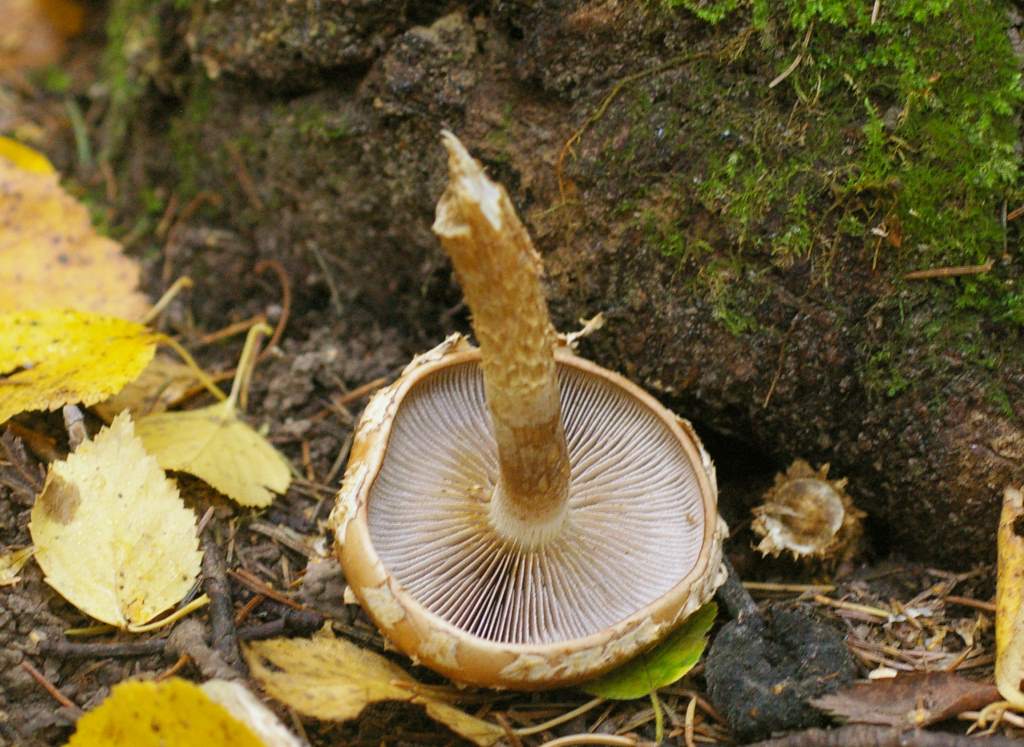
Yes - an old, dry and completely uninteresting representative of this amazing species. Of all the articles of white-crested scaly, here you can see only gray-violet plates, which, of course, is characteristic, but not very happy.
Lumpy scale
This fungus genus of phyolites, rich in "relatives", includes more than 150 species. Almost all of them are inedible due to their inherent bitter taste, and in some species, poisons are also noted.
One of the representatives of a large family, lumpy scaly, has not yet been fully studied, so, having met her in the forest, it is better to pass by. But how do you recognize her?
Lumpy scaly (Pholiota tuberculosa)
Lumpy scales - lat. Pholiota tuberculosa
This mushroom has no other names among the people. Unless they are sometimes confused with voles or field voles, which also belong to the tropharia family. But in scientific circles, Pholiota tuberculosa can also be found under other names:
- Pholiota curvipes
- Agaricus tuberculosus
- Pleuroflammula tuberculosa
- Dryophila tuberculosa
- Dryophila curvipes
- Hypodendrum tuberculosum
Mushroom cap
From the very beginning, the cap of tuberous scales has a convex shape with edges tucked inward. And when it reaches maturity, the edges of the cap are straightened, but it itself acquires a prostrate shape with a slight tubercle in the middle. In older specimens, the edge can even bend upwards and even break.
The diameter of the cap on average varies between 1-4.5 cm, however, mushrooms with smaller or larger caps from 5 mm to 5 cm in diameter can be found.
The surface of the cap is dry, covered with soft reddish brown or golden brown scales. A residual velum band is clearly visible along the edge of the cap - the bedspread.
The color of the cap, as well as the whole body of the mushroom, is reddish-yellow in any period of its growth.
The lumpy scale has a lamellar hymenophore. The plates themselves are quite wide. And if at the very beginning of the growth of the fungus the plates, covered with a private veil, have a color close to white, then in the process of growing up the veil breaks and disappears, and the color of the plates becomes brown-yellow, often with dark, like rusty specks.
Stipe
The brown-yellow or reddish-yellow cylindrical stem corresponds to the color of the entire body of the mushroom. Only above the annular zone, which quickly disappears, is there a whitish bloom against the background of the main yellow shade.
The structure of the stem is fibrous-felt, and its dimensions do not exceed 3 cm in length and 5 mm in width.
Growing places
Lumpy scales are fungi parasitizing on wood. Their main place of settlement is living and dead trees. However, it is often possible to find such scales on deadwood and stumps, which remain after cutting down a deciduous forest or windbreak.
Most often, the presence of lumpy scales is noted on lindens, birches, aspens, beeches and oaks during the period from August to October.
Edibility
At the moment, there is no reliable data on the edibility of lumpy flake, therefore this mushroom is classified as conditionally edible. However, the yellowish flesh has a bitter taste, which makes this mushroom unattractive to collectors. And the smell of the mushroom is not particularly aromatic.
Similar types and differences from them
The most similar to lumpy scaly is the luminous scaly - Pholiota lucifera. Some authors even consider these species to be the same, and their names are synonyms.However, the luminous scale still has differences in the shape of the cheilocystids and the structure of the pileipellis.
Early scaly (Agrocybe praecox)
- Other names for the mushroom:
- Early polevic
- Agrocybe early
- Early vole
Other names:
- Pholiota praecox
Early scaly (lat.Agrocybe praecox) is a mushroom of the Bolbitiaceae family. There are also known no less common synonyms, such as early scaly (Pholiota praecox) and early agrocybe.
Hat:
The width is 3-8 cm, in youth it is hemispherical with a distinct "pillow-like shape", with age it opens up to prostrate. The color is vaguely yellowish, light clay, sometimes fading in the sun to a dirty whitish color. In wet weather, faint signs of "zoning" can be found on the cap. The remains of the private bedspread often remain on the edges of the cap, which gives this mushroom a resemblance to representatives of the genus Psathyrella. The flesh of the cap is whitish, thin, with a pleasant mushroom smell.
Plates:
Quite frequent, wide, adherent to the "tooth"; in youth, light, yellowish, with age, as the spores mature, darken to dirty brown.
Spore powder:
Tobacco brown.
Leg:
The same color as the hat, darker at the bottom. The stem is hollow, but at the same time very stiff and fibrous. Height 5-8 cm, in the grass it can be higher; thickness up to 1 cm, although usually thinner. In the upper part, the remains of the ring, as a rule, are somewhat darker than the stem itself (they become even darker when the mushroom matures, being decorated with falling spores). The flesh is brownish, especially at the bottom.
Spreading:
Early flakes are found from early June to mid-July in gardens, parks, along the edges of forest roads, preferring rich soils; can settle on strongly rotted wood remains. In some seasons, it can bear fruit very abundantly, although it usually comes across less often.
Similar species:
Considering the timing of growth, it is rather difficult to confuse Early Scale with any other fungus. Closely related and outwardly similar species (such as, for example, Agrocybe elatella) are much less common. But it is much more difficult to distinguish it from the tough agrocybe (Agrocybe dura), the tough vole is usually whiter in appearance, grows more likely on silage than on wood remains, and its spores are several micrometers larger.
Edibility:
Early flakes - Normal edible mushroom, although some sources indicate bitterness.
Notes:
In the collector's understanding, Agrocybe praecox is a kind of "unfinished champignon". Growing conditions, discs darkening with age, strong dependence of size and weight on soil fertility - all this gives the right to treat this field as a champignon for the poor and hasty. Having met an old woman in the forest with a basket of selected agrocybians, I asked what she was collecting. “Why, chamignons, we eat them every year,” she replied. Inspired by this example, I also recruited early agrocytes and treated my friends. Champignons for ourselves and champignons, if you do not go into details, except for our brother, are of little interest to anyone.
Definitioner
- Basidia (Basidia)
-
Lat. Basidia. A specialized structure of sexual reproduction in fungi, inherent only in Basidiomycetes. Basidia are terminal (end) elements of hyphae of various shapes and sizes, on which spores develop exogenously (outside).
Basidia are diverse in structure and method of attachment to hyphae.
According to the position relative to the axis of the hypha, to which they are attached, three types of basidia are distinguished:
Apical basidia are formed from the terminal cell of the hypha and are located parallel to its axis.
Pleurobasidia are formed from lateral processes and are located perpendicular to the axis of the hypha, which continues to grow and can form new processes with basidia.
Subasidia are formed from a lateral process, turned perpendicular to the axis of the hypha, which, after the formation of one basidium, stops its growth.
Based on morphology:
Holobasidia - unicellular basidia, not divided by septa (see Fig. A, D.).
Phragmobasidia are divided by transverse or vertical septa, usually into four cells (see Fig. B, C).
By type of development:
Heterobasidia consists of two parts - hypobasidia and epibasidia developing from it, with or without partitions (see Fig. C, B) (see Fig. D).
Homobasidia is not divided into hypo- and epibasidia and in all cases is considered holobasidia (Fig. A).
Basidia is the place of karyogamy, meiosis and the formation of basidiospores. Homobasidia, as a rule, is not functionally divided, and meiosis follows karyogamy in it. However, basidia can be divided into probasidia - the site of karyogamy and metabasidia - the site of meiosis. Probasidium is often a dormant spore, for example in rust fungi. In such cases, probazidia grows with metabasidia, in which meiosis occurs and on which basidiospores are formed (see Fig. E).
See Karyogamy, Meiosis, Gifa.
- Pileipellis
-
Lat. Pileipellis, skin - differentiated surface layer of the cap of agaricoid basidiomycetes. The structure of the skin in most cases differs from the inner flesh of the cap and may have a different structure. The structural features of pileipellis are often used as diagnostic features in descriptions of fungi species.
According to their structure, they are divided into four main types: cutis, trichoderma, hymeniderma and epithelium.
See Agaricoid fungi, Basidiomycete, Cutis, Trichoderma, Gimeniderm, Epithelium.
- Trichoderma (Trichoderma)
-
The type of cap skin, usually consists of straight, septate elements located more or less perpendicular to the surface and laid both at the same and at different levels; the ends of the hyphae can be morphologically modified and represent dermatocystids. The surface of the cap is velvety to almost felt.
Lat. Trichoderm.
Trichoderma, in turn, is subdivided into intertwined trichoderma and irregular trichoderma.
Intertwined trichoderm (Intricate trichoderm) - trichoderm, consisting of intertwined hyphae, located not parallel to each other and forming a tomentose pubescence.
Irregular trichoderm - Trichoderma, consisting of irregularly branching hyphae.
See Dermatotsistida, Hypha, Septa.
- Cutis
-
The type of cap skin, consists of creeping non-gelatinized hyphae located parallel to the surface. The surface of the cap looks smooth.
Lat. Cutis.
See Gifa.



